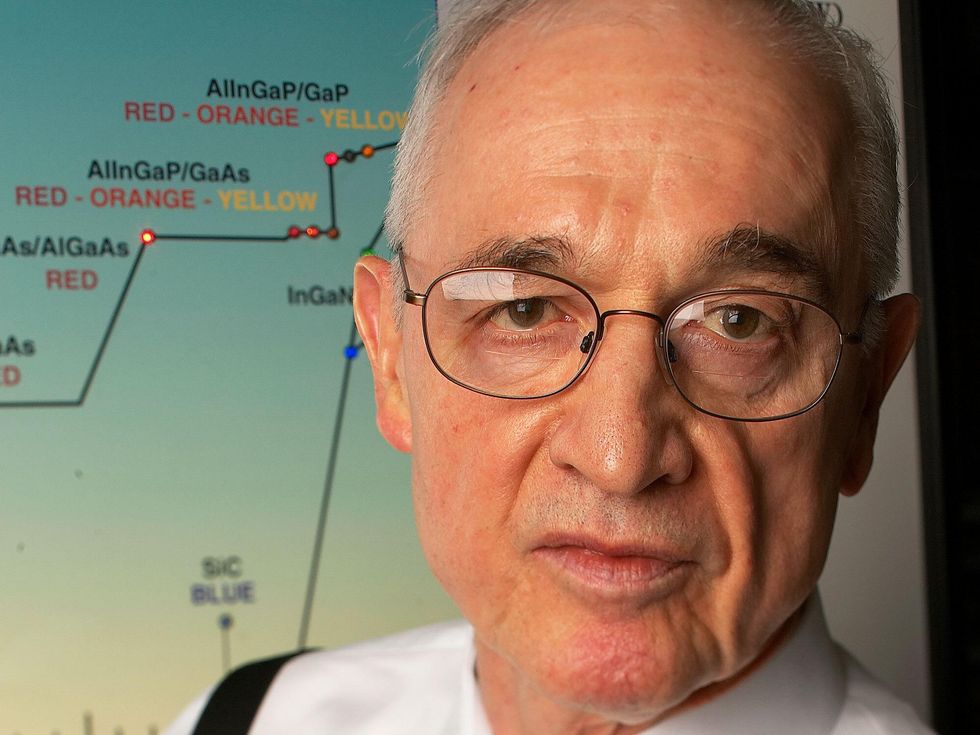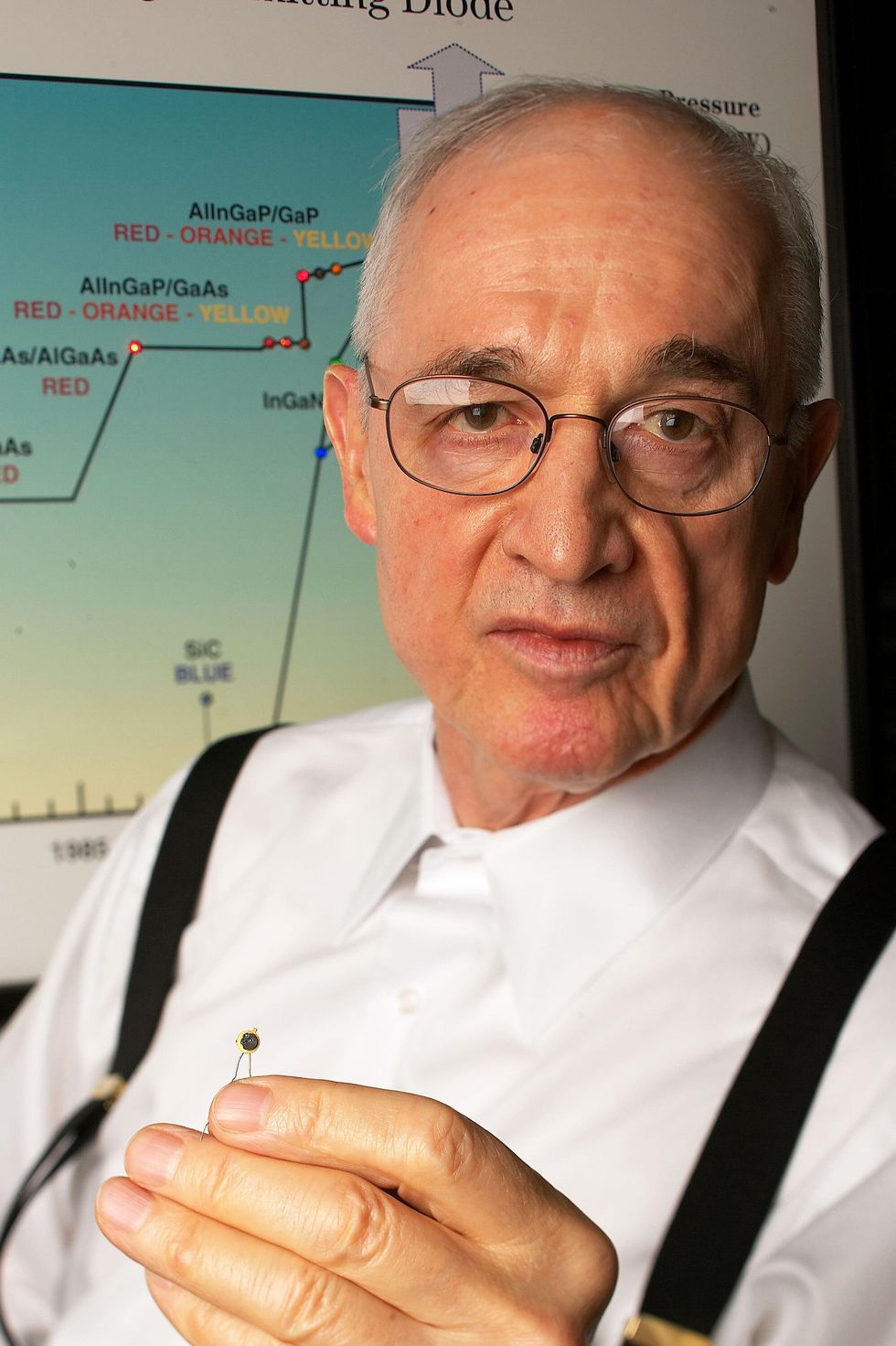

Nick Holonyak, Jr. retains a part of a stoplight that makes use of a newer LED designed by his college students. Ralf-Finn Hestoft/Getty Illustrations or photos
Nick Holonyak Jr., a prolific inventor and longtime professor of electrical engineering and computing, died on 17 September at the age of 93. In 1962, though operating as a consulting scientist at Standard Electric’s Superior Semiconductor Laboratory, he invented the to start with practical noticeable-spectrum LED. It is now made use of in gentle bulbs and lasers.
Holonyak left GE in 1963 to become a professor of electrical and computer engineering and researcher at his alma mater, the University of Illinois Urbana-Champaign. He retired from the university in 2013.
He acquired the 2003 IEEE Medal of Honor for “a profession of revolutionary contributions to semiconductors, such as the growth of semiconductor alloys and heterojunctions, and to obvious mild-emitting diodes and injection lasers.”
LED and other semiconductor market breakthroughs
Immediately after Holonyak acquired bachelor’s, master’s, and doctoral levels in electrical engineering from the University of Illinois, he was employed in 1954 as a researcher at Bell Labs, in Murray Hill, N.J. There he investigated silicon-primarily based digital devices.
He remaining in 1955 to provide in the U.S. Army Signal Corps, and was stationed at Fort Monmouth, N.J., and Yokohama, Japan. Just after getting discharged in 1957, he joined GE’s Sophisticated Semiconductor Laboratory, in Syracuse, N.Y.
When at the lab, he invented a shorted emitter thyristor device. The 4-layered semiconductor is now discovered in gentle dimmers and energy resources. In 1962 he invented the purple-mild semiconductor laser, regarded as a laser diode, which now is uncovered in cellphones as well as CD and DVD gamers.
Later that calendar year, he shown the 1st noticeable LED—a semiconductor source that emits mild when present flows by it. LEDs earlier had been designed of gallium arsenide. He produced crystals of gallium arsenide phosphide to make LEDs that would emit visible, purple mild. His get the job done led to the growth of the large-brightness, substantial-effectiveness white LEDs that are uncovered in a huge range of programs these days, together with smartphones, televisions, headlights, site visitors indicators, and aviation.
Pioneering study at the College of Illinois
Holonyak remaining GE in 1963 and joined the University of Illinois as a professor of electrical and personal computer engineering.
In 1977 he and his doctoral students demonstrated the very first quantum nicely laser, which afterwards located purposes in fiber optics, CD and DVD gamers, and healthcare diagnostic resources.
The university named him an endowed-chair professor of electrical and laptop engineering and physics in 1993. The placement was named for John Bardeen, an honorary IEEE member who had acquired two Nobel Prizes in Physics as perfectly as the 1971 IEEE Medal of Honor. Bardeen was Holonyak’s professor in graduate college. The two men collaborated on research initiatives right until Bardeen’s dying in 1991.
Alongside one another with IEEE Lifestyle Fellow Milton Feng, Holonyak led the university’s transistor laser research centre, which was funded by the U.S. Defense State-of-the-art Exploration Initiatives Agency. There they produced transistor lasers that experienced the two gentle and electric powered outputs. The innovation enabled high-velocity communications systems.
Much more just lately, Holonyak developed a approach to bend light-weight within just gallium arsenide chips, making it possible for them to transmit information and facts by mild alternatively than electric power.
He supervised extra than 60 graduate learners, numerous of whom went on to grow to be leaders in the electronics field.
Queen Elizabeth prize, Draper prize, and other awards
Holonyak gained previous year’s Queen Elizabeth Prize for Engineering the Nationwide Academy of Engineering’s 2015 Draper Prize the 2005 Japan Prize and the 1989 IEEE Edison Medal. In 2008 he was inducted to the National Inventors Corridor of Fame, in Akron, Ohio.
He was a fellow of the American Academy of Arts and Sciences, the American Bodily Culture, and Optica. He was also a foreign member of the Russian Academy of Sciences. In addition Holonyak was a member of the U.S. Academies of Engineering and Sciences.
Go through the whole story about Holonyak’s LED breakthrough in IEEE Spectrum.








